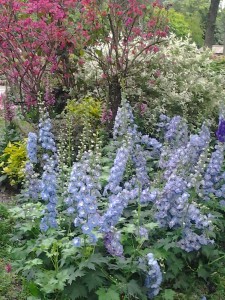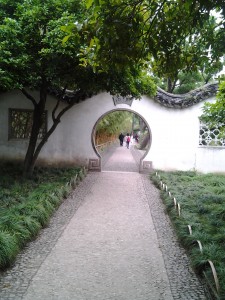UPDATE: Author is reminded how to work his wife’s electronic mystery machine; photographs are added.
On a recent escape from Dalian – where lie wage-earning, grocery-getting and stale routine – my little nucleus explored choice cuts of Suzhou and Beijing. I dwelt on some of the unpleasant things of life in the Venice of the Orient here and here, but there was a great deal to like, especially when we were free to wander in parts of the old city less infested with tourist buses.
My bride and I strolled narrow Pingjiang Lu, and sure, it was meant for tourists, but it wasn’t garish, and it wasn’t wide enough for cars (let alone buses), and there were genuinely pleasant sights: bits of canal-watching, a pottery shop stocked with original pieces, Jiangsu street foods we hadn’t sampled before, and frequent tableaus of young Chinese women dressed in, I guessed, early 20th-century costume in the Chinese bride’s eternal quest — well, eternal for the last few years, anyway — for the perfect pre-marital backdrop. (I first thought the young women in sundresses and parasols lounging by the canal for a smoke, which is rather risqué and newly fashionable in China, might be “working girls”, but they were likely just waiting to turn a photographic trick.)
We’d heard about the “Humble Administrator’s Garden”, purported to be a UNESCO World Heritage Site, and had walked near it on the slightly nightmarish previous day. (Our braying, singing, silk-hawking tour guide from the day before might have pointed vaguely towards it as we puttered down the canal in our touristic prison-ship. I wasn’t impressed.) When we turned on to the wider, busier street that Monday, my wife was likely thinking of her Mum when she decided to go see the place. I could’ve been thinking of my own garden-loving, now-hoeing-in-a-higher-row mother, too, but I got clench-jawed and cheap. Seventy yuan? Over ten bucks to visit a garden? It’ll probably just get me mad again, I carped, but my girl gentled me into it, and it was another good thing she did.
The Administrator might’ve been humble, though I doubt it; his garden is anything but. It is gorgeous, tasteful, varied and wonderfully planned. It was a weekday afternoon, so there were hundreds rather than thousands of visitors. It may just have been good luck, but there was only one amplified tour guide breaking the peace of that place in the 90 minutes we spent there. The smells and colours were exquisite, including the exotic feathering of the male members of the duck pairs that reigned over a series of ponds. Here and there were pavilions where the pampered mandarins might take tea. (I couldn’t stop thinking of the privileged nature of those with the resources to develop and enjoy such a large chunk of land, but I didn’t let socio-historic scroogery ruin my afternoon. Good for me.)
I loved the walkways, painstakingly laid out with rounded stones set in concrete, or thin black rectangles of something like slate laid side by side in the earth. I enjoyed how bunches of what looked like Kentucky bluegrass sprouted from earthy niches among funky rocks and curving walkways. I stared for ten minutes at the fresh, springy green of the delicate star-shaped leaves of a modest-sized, gnarled tree. You’d have thought I’d never seen anything like it before. I hadn’t. This place was a refuge that I’d buy season’s tickets for if I lived in Suzhou. It was many kinds of inspiration, too, for a middle-aged man now ready to be a gardener, missing his compost and his little plot of earth in Ottawa: I took visual notes, and thought again about the sunflowers I’d plant by our back southward fence; imagined boxes of flowers and greenery by our narrow front approaches, and ivy scaling the plain-bricked side of the house; challenged myself to save smooth and rounded stones for a tiny front patio design, instead of side-arming them to skip across lakes and rivers because that’s what you DO with the perfect stone; and, yes, reminded myself to learn better how to prune the flowering Enid in the back yard, the small tree I’d planted and named after my blossom-mad, blooming crazy mother, just before we decided to live in China for a year, half a decade ago.
That magnificent Suzhou garden was all so well done, so patiently and carefully made with an eye to beauty, repose and permanence, something I’d second UNESCO in calling a treasure, at least for my world. It was a rebuke and a contrast to the blazingly fast pace of development in modern Chinese cities, where the buildings are often hastily made, and with little apparent concern for maintenance or endurance. The garden felt organic, at least in the aesthetic sense; I wouldn’t bet against chemical pesticides and fertilizers, lovestruck though I was. It was lovely, serene, quietly spectacular without being showy. It was made with eternity in mind. Stone walls featured square openings that contained a particularly splendid view behind them, and round hobbit-doors gave a more feminine framing to whatever new vista emerged from beyond.
Closing time came, and the spell still wasn’t broken. A female voice, like softly falling water – first in Chinese, then in a delightfully well-intentioned Chinglish – bid us a gentle and quirky good-bye: “Our garden will be closed in no time. Please take your time and head for the exit in order. Welcome to our garden again. Thank you.” I could’ve stayed much longer, but I got more than my 70 yuan’s worth. Only as we left did a note of alarm creep in: I saw that we had to negotiate a whole block or more of specialized tourist-shops before we got back to the air horns and hawkers of the main tourist street. I wanted my eyes to remember gardens, not glitz, the art of the earth-bound, not commercial crass. I’m an idiot, indeed, but my wife didn’t seem to mind holding me by the arm and walking me through as I kept my eyes closed. (Try it some time; it’s not so easy, and an excellent exercise in trust and disregarding the opinions of others.) It was a silly symbol, I know, but I can see the Humble Administrator’s Garden in my mind, still, so I count that as a win for the visiting team.
A few days later, in Beijing, I loosened my purse-strings again for a green slice of holy ground…
Part Two of this garden-happy travelogue, longer but less flowery, is here.




